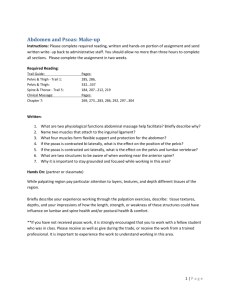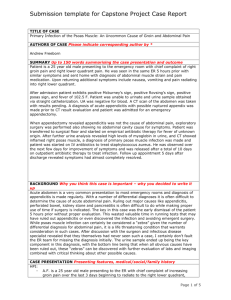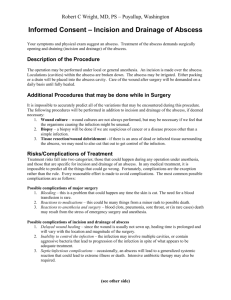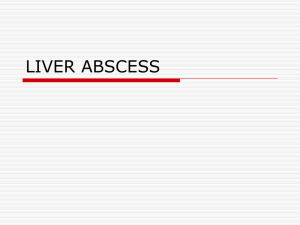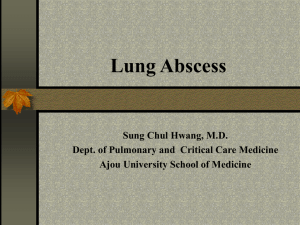Psoas Abscess
advertisement
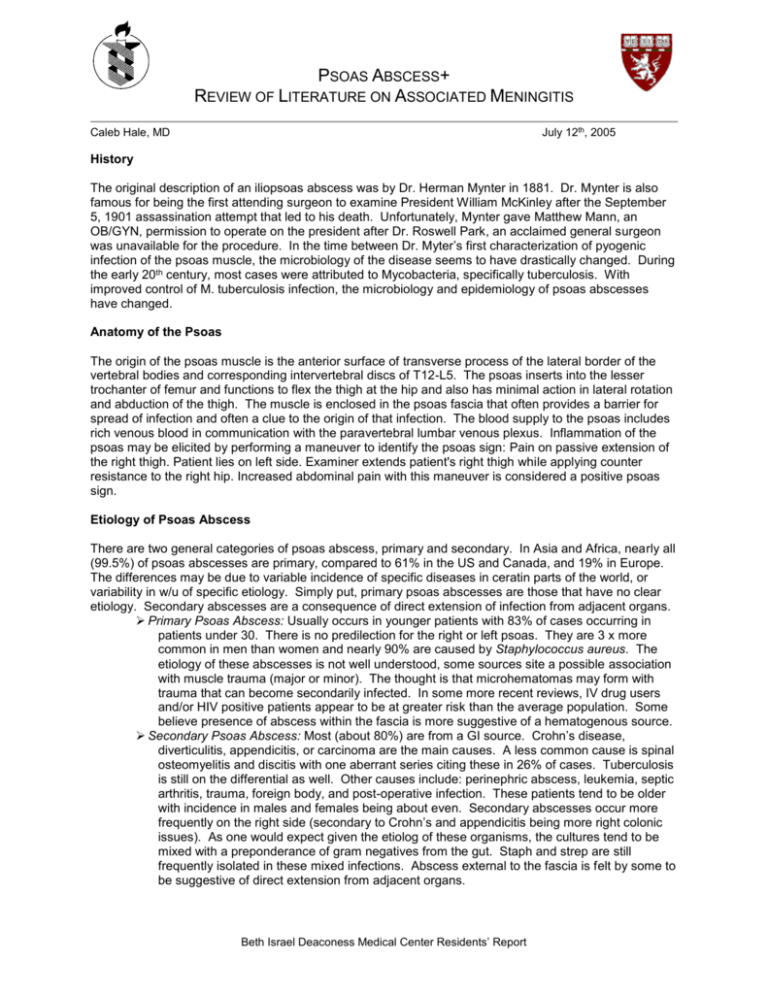
PSOAS ABSCESS+ REVIEW OF LITERATURE ON ASSOCIATED MENINGITIS July 12th, 2005 Caleb Hale, MD History The original description of an iliopsoas abscess was by Dr. Herman Mynter in 1881. Dr. Mynter is also famous for being the first attending surgeon to examine President William McKinley after the September 5, 1901 assassination attempt that led to his death. Unfortunately, Mynter gave Matthew Mann, an OB/GYN, permission to operate on the president after Dr. Roswell Park, an acclaimed general surgeon was unavailable for the procedure. In the time between Dr. Myter’s first characterization of pyogenic infection of the psoas muscle, the microbiology of the disease seems to have drastically changed. During the early 20th century, most cases were attributed to Mycobacteria, specifically tuberculosis. With improved control of M. tuberculosis infection, the microbiology and epidemiology of psoas abscesses have changed. Anatomy of the Psoas The origin of the psoas muscle is the anterior surface of transverse process of the lateral border of the vertebral bodies and corresponding intervertebral discs of T12-L5. The psoas inserts into the lesser trochanter of femur and functions to flex the thigh at the hip and also has minimal action in lateral rotation and abduction of the thigh. The muscle is enclosed in the psoas fascia that often provides a barrier for spread of infection and often a clue to the origin of that infection. The blood supply to the psoas includes rich venous blood in communication with the paravertebral lumbar venous plexus. Inflammation of the psoas may be elicited by performing a maneuver to identify the psoas sign: Pain on passive extension of the right thigh. Patient lies on left side. Examiner extends patient's right thigh while applying counter resistance to the right hip. Increased abdominal pain with this maneuver is considered a positive psoas sign. Etiology of Psoas Abscess There are two general categories of psoas abscess, primary and secondary. In Asia and Africa, nearly all (99.5%) of psoas abscesses are primary, compared to 61% in the US and Canada, and 19% in Europe. The differences may be due to variable incidence of specific diseases in ceratin parts of the world, or variability in w/u of specific etiology. Simply put, primary psoas abscesses are those that have no clear etiology. Secondary abscesses are a consequence of direct extension of infection from adjacent organs. Primary Psoas Abscess: Usually occurs in younger patients with 83% of cases occurring in patients under 30. There is no predilection for the right or left psoas. They are 3 x more common in men than women and nearly 90% are caused by Staphylococcus aureus. The etiology of these abscesses is not well understood, some sources site a possible association with muscle trauma (major or minor). The thought is that microhematomas may form with trauma that can become secondarily infected. In some more recent reviews, IV drug users and/or HIV positive patients appear to be at greater risk than the average population. Some believe presence of abscess within the fascia is more suggestive of a hematogenous source. Secondary Psoas Abscess: Most (about 80%) are from a GI source. Crohn’s disease, diverticulitis, appendicitis, or carcinoma are the main causes. A less common cause is spinal osteomyelitis and discitis with one aberrant series citing these in 26% of cases. Tuberculosis is still on the differential as well. Other causes include: perinephric abscess, leukemia, septic arthritis, trauma, foreign body, and post-operative infection. These patients tend to be older with incidence in males and females being about even. Secondary abscesses occur more frequently on the right side (secondary to Crohn’s and appendicitis being more right colonic issues). As one would expect given the etiolog of these organisms, the cultures tend to be mixed with a preponderance of gram negatives from the gut. Staph and strep are still frequently isolated in these mixed infections. Abscess external to the fascia is felt by some to be suggestive of direct extension from adjacent organs. Beth Israel Deaconess Medical Center Residents’ Report Clinical Presentation Often difficult to diagnose based on history and physical alone. The classic presentation includes fever, flank pain, abdominal pain, limp, and hip flexion contracture (flexion and external rotation of the ipsilateral hip). Sometimes the pain of the abscess will radiate to the inguinal region and is occasionally associated with a palpable inguinal mass. Pain may also radiate to the hip, thigh, or knee. Psoas abscess may also be the cause of fevers of unknown origin, following a more chronic course with long-term fevers, constitutional symptoms, and weight loss. Other findings include absent femoral pulse, rectal tenderness, and wasting of the quadriceps femoris muscle. Labs are significant for leukocytosis and if checked an elevated ESR. Anemia and pyuria may also be non-specific lab findings. Definitive diagnosis is with an imaging modality. The most frequently used is the CT scan or ultrasound. The benefit of the CT is that it can evaluate the patient for the etiology of the abscess if found. This may change management. Calcification of the psoas is suggestive of a mycobacterial infection. 40-70% of patients will have positive bacterial blood cultures. Treatment/Prognosis Like all abscesses, treatment is interdisciplinary with surgical and medical co-management. Empiric antibiotics should include agents that cover bowel flora as well as S. aureus. In cases where bowel pathology is identified, open surgery is the preferred route of draining these abscesses. In cases where no bowel pathology is identified, the approach tends to be more percutaneous drainage with the help of CT or US guidance. Antibiotics alone do not tend to be enough, especially in secondary abscess with a 50% failure rate reported by some sources. There has been some success with treatment of primary abscess with antibiotics alone. Duration of therapy is usually 2-3 weeks after defervescence and cessation of drainage. Mortality from primary abscess is 2.5% with secondary abscess carrying a nearly 20% mortality rate. Mortality increases with delay of definitive treatment. Rare Complication: Meningitis As noted above, the vascular supply of the psoas muscle is in communication with the paravertebral venous plexus. The lack of valves in this system allows the direction of blood flow to be dependant on intrathoracic and intraabdominal pressure. This is the suspected mechanism for seeding of the psoas by extension of spinal osteomyelitis and discitis. Though rare, the reverse direction of infection may also occur with psoas abscesses leading to epidural abscesses, osteomyelitis, and meningitis. In reviewing the literature only a handful of cases of psoas muscle abscess leading to meningitis have been reported. Of those cases, the majority have been caused by secondary psoas abscess from an intestinal source. Only one other case of primary psoas abscess leading to S. aureus meningitis exists in the literature. The take home message is to remember that the psoas is close to many organs and neurological structures that share its blood flow. Care should be taken to treat these abscesses with appropriate antibiotics and surgical management to avoid associated complications. Bibliography Desandre, AR. Iliopsoas Abscess: Etilogy, Diagnosis. And Treatment. Am Surg. 1995: 61: 1087-91. Gruenwald, I. Psoas Abscess: Case Report and Review of the Literature. J. Uro. 1992: 147: 1624-6. Orrison, WW. Fatal meningitis secondary to undetected bacterial psoas abscess. J. Neurosurg. 1977; 47:755-760. Spotkov, Jared. Staphylococcal meningitis: a complication of psoas abscess. Neurology 1985; 35: 110111. Van Dellen, JR. Meningitis caused by psoas abscess. South African Medical Journal. 1980; 52: 552-3. Beth Israel Deaconess Medical Center Residents’ Report Beth Israel Deaconess Medical Center Residents’ Report

